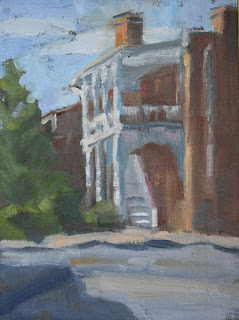"Bialetti"
11 x 14
We painters spend a lot of time fretting about "edges". In fact, I believe that one of the key elements of a successful painting is varying the treatment of edges, and making the right choices as to which edges should be "hard" and which ones "soft".
Sometimes an edge can be made so soft that it virtually disappears. These are what we call "lost edges"--places where there is literally no delineation between two objects. I love to find opportunities to lose edges. It is amazing how little definition between objects is actually required, because the viewer's brain will fill in lots of missing information.
In this painting, I challenged myself to create a number of lost edges. I managed to completely lose the left edge of the tall vessel behind the Bialetti coffee maker, letting it blend right in with the background, as you see can in this detail:
I loved this edge treatment...it helped move the tall vessel into the background, and the sharp, hard edge of the Bialetti spout comes forward by comparison.
I also lost the right edge of the little yellow pitcher, letting it fade in to the larger pitcher behind it (detail below):
I saved the crisp edges in this painting for the Bialetti coffee maker, which is the main subject, and for the spouts of the various containers, which are all pointing inward to draw the eye in. Great fun.
One could make a game of counting the hard and soft edges in this painting. Lori Woodward says that the mark of a professional painting is that it includes several lost edges. I wonder whether she would find that this painting makes the mark?
By the way, if you notice the reddish hue on one of the surfaces of the Bialetti, it is a reflection from the red apron I was wearing while working on the painting. So there is a hint of a self portrait in this canvas!
Here's another painting featuring my little Bialetti coffee maker. See if you can find the lost edges in this one!
"Italian Breakfast"
12 x 16














